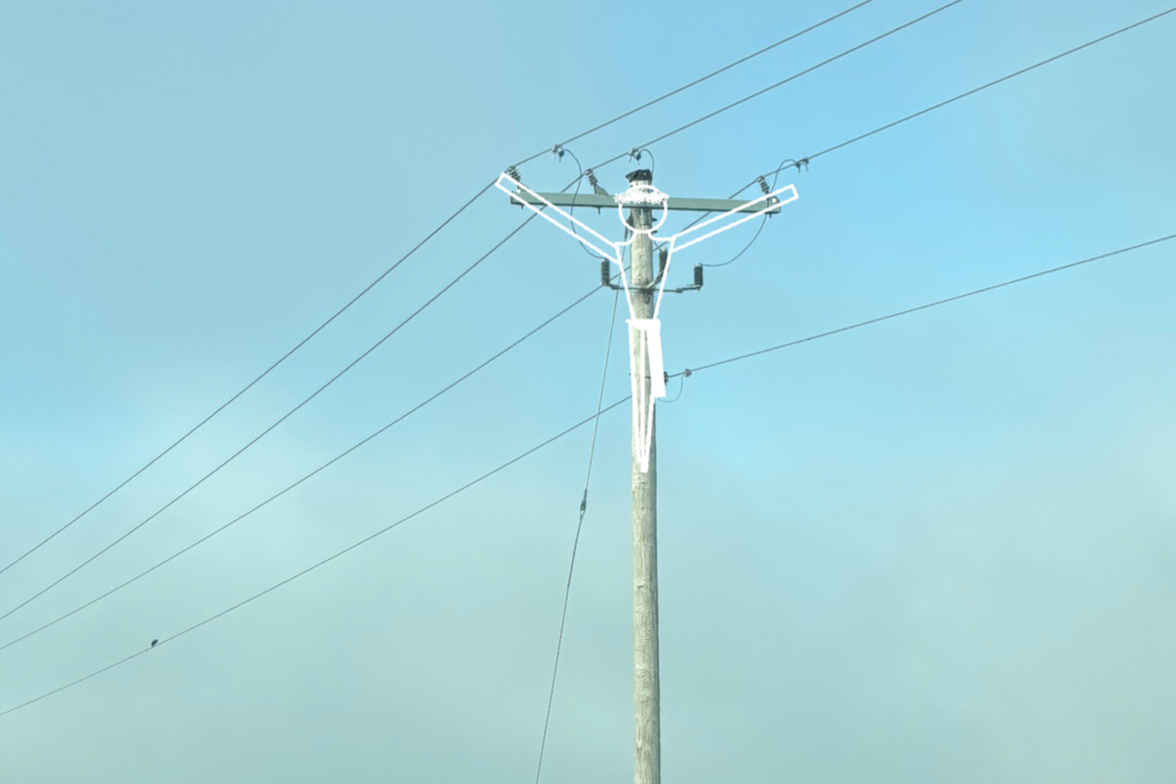Crucifix Pareidolia
August 18, 2025 | By Isaac Oberman DC ‘26
Original image by author
Humans have the striking capacity to see faces in the smallest details. It’s called Pareidolia, a word that came into the English language from Greek via German. Para- means “alongside” or “instead of”, while -eidolon translates to “image,” “form,” or “shape.” It can be used to describe any visual pattern that seems to represent a meaningful image, like a cloud shaped as a fish or a piece of toast that looks like Michael Jackson came back from the grave [1]. Pareidolia is primarily used to describe a type of personification in which humans see faces in everyday objects and assign character to them, like a wall outlet screaming out in horror or a car’s grill smiling as you pass by. Evolutionary biologists believe it was a defense mechanism developed to be more adept at identifying predators with camouflage [2]. Regardless of its origin, it reveals a deeper truth about humanity’s relationship to our surroundings. We are social creatures who long for connection, and this manifests in a desire to imbue our intimate objects —the daily tools and keepsakes we hold dear—with character that fits the drama of our lives. “All the world’s a stage, and all the men and women merely players” [3], but perhaps our props can be players as well.
However, Pareidolia is not always neat and unobtrusive. For instance, I see crucifixes everywhere.
It would be easier to say that the statement was purely for shock value. No! [4]. The image of a telephone pole turned crucifix shown at the top of this article seems farcical–a blocky silhouette splayed on a telephone pole–but that is what I have come to see. One day, the silhouette appeared and now remains, burned into my retina like a flash of sun. Every morning, I pass this telephone pole on my way to work, and He stares back from the telephone pole. He does not encourage me to look at him. He does not beg either. He simply holds my eyes in his, gratifying to look upon.
I’m especially attuned to telephone poles, but the phenomenon is not exclusive. Flagpole? Crucifix. Chopsticks overtop one another in a bowl? Crucifix. Perpendicular lines are best, but really, anywhere there are two overlapping lines is sufficient. The best is construction. The I-beams, towering up into the sky, linked with girders and massive bolts, manifest as a web of crucifixes holding up the structure. Each looks at me, and I am drawn into their gazes.
There are probably many ways to explain away the occasions of spontaneous crosses. Perhaps my mind is bored. Seeing the hanging bodies gives my surroundings an occasion for spectacle. I might have a freak eye problem, where my vision is obstructed by a Christ-shaped cataract. Most likely, I surround myself with so much religious content in my daily life that my mind actively seeks it out and creates it. But all of these explanations are boring and surface-level. Let’s get mystical. What if the crucifix is supposed to be there?
We will use a tree as our model for this thought. The tree serves well as a subject because there is an obvious parallel to a crucifix, which is often referred to as a tree. How do we know what makes a tree a Tree? Treeness, as an attribute, is derived through the conglomeration of the features of trees that are held in common. Bark, leaves, branches, and roots are all essential components of what makes a tree a Tree. However, included in this idea of Treeness are also the less tangible ideas and adjectives we subconsciously understand when we speak of trees: shady spots to rest in the summer, a redwood’s sheer size and might, climbing pines and the exhilaration of height, or even literature such as Shel Silverstein’s The Giving Tree. Included within this once again is the cross, the tree on which Jesus died. The Tree does not exist without all of these ideas together, like a wagon wheel with each spoke pointing in toward the center. Some spokes might be bigger than others, but each spoke is a part of the wheel.
This rather bold statement prompts the essential question, “Which spoke is biggest?” Ralph Waldo Emerson, the noted transcendentalist, asked this same question when musing over a cord of wood [5]. He refused to see the wood as anything but the remnant of an “enchanted forest” [6]. elevating the wood to a greater degree than its material value. He takes an idea from within the form of Wood, ‘the enchanted forest,’ and envisions the wood through this new window. The wood assumes a pareidolic character as a magical product, bringing us closer to a sense of the wonder of the created world. It’s more than mere symbolism; the wood becomes enchanted by acknowledging an aspect that is not externally communicated by the wood but that is still a component of its identity on a lesser level. A smaller spoke appears larger. Similarly, the crucifix, an idea that exists within the conception of Treeness but is not as readily apparent, becomes stuck in one's view and causes the tree to become a crucifix, not just in conceptual representation but in perceptual realization.
This last line needs to be expanded. Our thesis on pareidolia extends beyond most scientific definitions of the phenomenon, which typically describe it as ‘symbol recognition.’ A podcast episode from Cognitive Bias discussed animals as capable of pareidolia when they observe biological camouflage, such as a moth with a wing pattern that resembles an owl’s eyes [7,8]. I find this to be lacking. There is a difference between understanding symbols as an image when they are meant to resemble that image, and seeing images when the underlying objects are not visually communicating the image. The moth is actively communicating the image of an owl to predators, but a tree is not actively communicating a crucifix. Instead, passive communication takes place. The perceiver makes a visual connection and receives a communication without a meaningful contribution from the perceived. This is why Pareidolia is dependent on the individual; not everybody sees two monkeys dancing in a Rorschach test. But I, as a subjective viewer, see the crucifix in the tree. And now it is no longer just a tree. Because the connection was made by my brain and not communicated by the tree intentionally, it exists within my brain as a crucifix. That is another important part of pareidolia: it is really hard to decentralize your pareidolic impression. When you see a wall outlet as a face, that image will always be present in your vision. You have to try to unsee it actively. But the moment you stop focusing, the face you saw returns!
The tree is just the starting point. The letter X is St. Andrew’s cross. That rose bush is the crown of thorns. If we were to take it even a step further, we could cite Ephesian 4:6: “One God and Father of all, who is over all and through all and in all.” This verse requires the envisioner to grapple with the religious reality of God’s omnipresence in the world and His redemption of it, centralized in the crucifixion. What that means for us though is that God’s presence is an intrinsic aspect of an object’s existence. Once we acknowledge that any physical object has within its form the concept of God on the cross, He can pop out and then become what we envision. When God is present in every form, Pareidolia makes one see the entire world as a crucifix. And now the outlet in the wall is not just a screaming face; it exclaims praise of Christ crucified. The smiling car grill beams in recollection of the sacrifice made to redeem the world. Crucifix Pareidolia is a help to the Christian needing a reminder that all creation sings of God [9], and maybe more literally than we think.
[1] https://news.bbc.co.uk/2/hi/entertainment/4114248.stm
[2] https://thesciencesurvey.com/editorial/2021/04/23/perception-in-pareidolia/
[3] As You Like It, Shakespeare
[4] Well, maybe a little shock value.
[5] A cord is a measurement of a pile of wood that is 4 feet tall, 4 feet deep, and 8 feet long.
[6] “For form’s sake, or for wantonness, I sometimes chaffed with the farmer on the price of a cord of wood, but if he said twenty dollars instead of five, I should think it cheap when I remember the beautiful botanical wonder–the bough of an oak–which he brings me so freely out of the enchanted forest where the sun and water, air and earth, and God formed it.” - Emerson’s Journal, pg 80
[7] While no longer active, they have some good episodes detailing all sorts of psychological topics! https://open.spotify.com/show/0zULlDxebf6xUeVWCZHTVy
[8] Polyphemus Moths have distinct eyespots on the lower range of their wings, and are named for the Cyclops in the Odyssey (which is awesome).
[9] Psalm 148 NCB

